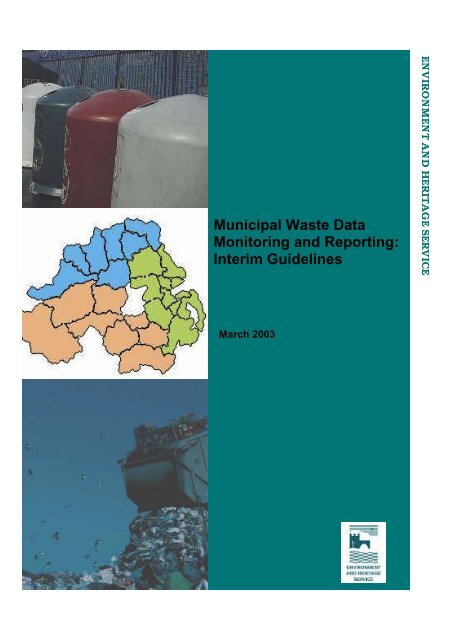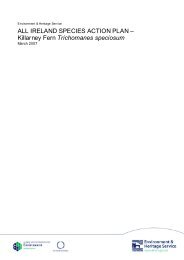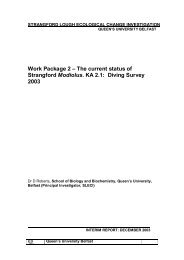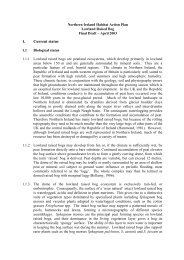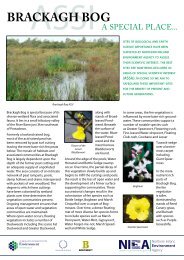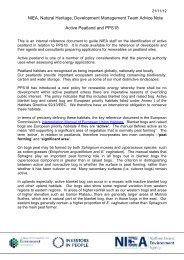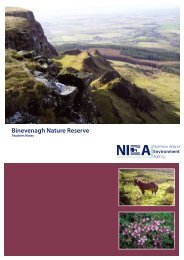Municipal Waste Data Monitoring and Reporting: Interim Guidelines
Municipal Waste Data Monitoring and Reporting: Interim Guidelines
Municipal Waste Data Monitoring and Reporting: Interim Guidelines
You also want an ePaper? Increase the reach of your titles
YUMPU automatically turns print PDFs into web optimized ePapers that Google loves.
<strong>Municipal</strong> <strong>Waste</strong> <strong>Data</strong><br />
<strong>Monitoring</strong> <strong>and</strong> <strong>Reporting</strong>:<br />
<strong>Interim</strong> <strong>Guidelines</strong><br />
March 2003<br />
ENVIRONMENT AND HERITAGE SERVICE
CONTENTS<br />
ABBREVIATIONS<br />
1 INTRODUCTION 1<br />
1.1 BACKGROUND 1<br />
1.2 OBJECTIVES 1<br />
1.3 PHASED IMPLEMENTATION 1<br />
1.4 WASTE DATA MONITIORING AND REPORTING TASKFORCE 2<br />
2 THE NEED FOR WASTE DATA REPORTING 3<br />
2.1 EHS REQUIREMENTS 3<br />
2.2 LEGAL REQUIREMENTS 4<br />
3 INTERIM GUIDELINES 6<br />
3.1 TERMINOLOGY 6<br />
3.2 METHODOLOGY 6<br />
3.3 APPOINT A DATA REPORTING OFFICER (STEP 1) 7<br />
3.4 IDENTIFY WASTE COLLECTION AND WASTE PROCESSING STREAMS (STEP 2) 7<br />
3.5 DATA MEASUREMENT, RECORDING & DEVELOPMENT OF A DATABASE (STEP 3) 8<br />
3.6 WASTE MANAGEMENT PLAN TARGETS – CRITICAL PATHS, TRIGGER POINTS AND<br />
CONTINGENCYPLANS (STEP 4) 10<br />
3.7 KPIS, MONITORING AND REPORTING (STEP 5) 10<br />
4 DATA QUALITY REQUIREMENTS 13<br />
4.1 DATA QUALITY 13<br />
5 CONCLUSION 15<br />
ANNEX A: WASTE MANAGEMENT PRIMARY AND SECONDARY KEY<br />
PERFORMANCE INDICATORS<br />
ANNEX B: EUROPEAN UNION WASTE MANAGEMENT DIRECTIVES<br />
ANNEX C: DEFINITIONS OF WASTE MANAGEMENT TERMS<br />
ANNEX D: KPI DEFINITIONS<br />
ANNEX E: WEIGHT CONVERSION FACTORS<br />
CALCULATING WEIGHT WITHOUT WEIGHBRIDGES<br />
ANNEX F: TYPICAL EXAMPLES OF DATA RECORDING FORMS<br />
ANNEX G: WORKSHEETS FOR CALCULATING KPIS: INSTRUCTIONS FOR USE
ABBREVIATIONS<br />
BATNEEC Best Available Technology Not Entailing Excessive Cost<br />
BMW Biodegradable <strong>Municipal</strong> <strong>Waste</strong><br />
BPEO Best Practicable Environmental Option<br />
BVPI Best Value Performance Indicator<br />
C&I Commercial <strong>and</strong> Industrial<br />
DC District Council<br />
DEFRA Department of the Environment, Food <strong>and</strong> Rural Affairs<br />
DOE Department of the Environment<br />
DRD Department of Regional Development<br />
DSD Department of Social Development<br />
EHS Environment <strong>and</strong> Heritage Service<br />
ELV End of Life Vehicles<br />
ERM Environmental Resources Management<br />
EWC European <strong>Waste</strong> Catalogue<br />
IDBR Inter Departmental Business Register<br />
IPPC Integrated Pollution Prevention <strong>and</strong> Control<br />
KPI Key Performance Indicators<br />
MRF Material Recycling/Recovery Facility<br />
NGO Non Governmental Organisation<br />
OECD Organisation for Economic Co-operation <strong>and</strong> Development<br />
OJEC Official Journal of the European Communities<br />
PCB Polychlorinated Biphenyls<br />
SIC St<strong>and</strong>ard Industrial Classification<br />
SWaT Special <strong>Waste</strong> Tracking <strong>Data</strong>base<br />
WEEE <strong>Waste</strong> Electrical <strong>and</strong> Electronic Equipment<br />
WET Bill <strong>Waste</strong> <strong>and</strong> Emissions Trading Bill<br />
WMP <strong>Waste</strong> Management Plan<br />
WMS <strong>Waste</strong> Management Strategy<br />
WRAP <strong>Waste</strong> <strong>and</strong> Resources Action Programme<br />
WSR <strong>Waste</strong> Statistics Regulation
1 INTRODUCTION<br />
1.1 BACKGROUND<br />
1.2 OBJECTIVES<br />
The Environment <strong>and</strong> Heritage Service of the Department of the Environment<br />
has prepared guidance on municipal waste data reporting for use by District<br />
Councils <strong>and</strong> the sub-regional waste management planning groups (<strong>Waste</strong><br />
Management Groups) in their regular monitoring <strong>and</strong> annual performance<br />
reviews, to which they have committed in the final <strong>Waste</strong> Management Plans<br />
(WMPs).<br />
The objectives of the monitoring <strong>and</strong> reporting guidelines are:<br />
• To identify appropriate key performance indicators that need to be<br />
measured to assess progress towards achieving the <strong>Waste</strong> Strategy<br />
Targets;<br />
• To enable compliance with the reporting requirements of EU Directives,<br />
the Department <strong>and</strong> other UK legislation;<br />
• To ensure uniform <strong>and</strong> consistent measurement <strong>and</strong> presentation of the<br />
key performance indicators across the whole of Northern Irel<strong>and</strong> (NI).<br />
1.3 PHASED IMPLEMENTATION<br />
The implementation of the guidelines has been split into three stages:<br />
Stage 1 involved the development of an outline list of primary key<br />
performance indicators (KPIs) for waste management for inclusion in the<br />
adopted WMP. These indicators are listed in Annex A.<br />
Stage 2 entails the development of <strong>Interim</strong> <strong>Guidelines</strong>. These provide details of<br />
the methodology to be adopted in reporting waste data in the annual review<br />
to be carried out by the regional <strong>Waste</strong> Management Groups in March/April<br />
2003. They will also be used for measuring <strong>and</strong> reporting waste data<br />
throughout 2003. This stage has also involved further development of the<br />
primary indicators outlined in Stage 1 <strong>and</strong> the definition of secondary<br />
indicators, as appropriate – see Annex A<br />
Stage 3 will involve the production of formal <strong>Reporting</strong> <strong>Guidelines</strong>. These<br />
guidelines will be produced prior to the annual review of the WMPs in March<br />
2004. This phase of the project will include consultation with the District<br />
Councils by October 2003, <strong>and</strong> finalisation <strong>and</strong> issue of the <strong>Guidelines</strong> by 31<br />
December 2003. It is the Department’s intention to make the final guidelines<br />
statutory in due course.<br />
MUNICIPAL WASTE DATA MONITORING AND REPORTING: INTERIM GUIDELINES 1
The benefits of this staged approach are that a functional methodology can be<br />
quickly developed to achieve the March 2003 milestone. In addition, by<br />
delaying the finalisation of the guidelines until December 2003, the<br />
methodologies developed in Stages 1 <strong>and</strong> 2 can be further refined, based on<br />
the results of their implementation in the first round of annual performance<br />
reviews in March/April 2003, <strong>and</strong> of any further pilot testing considered<br />
necessary. Furthermore, any reporting requirements of EU Directives yet to<br />
be confirmed (e.g. the L<strong>and</strong>fill Directive <strong>and</strong> the <strong>Waste</strong> Statistics Regulation)<br />
can be incorporated into the final version of the guidelines.<br />
1.4 WASTE DATA MONITORING AND REPORTING TASKFORCE<br />
The <strong>Interim</strong> <strong>Guidelines</strong> outlined in this report have been developed by the<br />
Department, in conjunction with the <strong>Data</strong> <strong>Monitoring</strong> <strong>and</strong> <strong>Reporting</strong><br />
Taskforce. The Taskforce consists of representatives from: the three <strong>Waste</strong><br />
Management Groups, the Department (<strong>Waste</strong> <strong>and</strong> Contaminated L<strong>and</strong> Unit),<br />
DRD (Central Statistics <strong>and</strong> Research Branch) <strong>and</strong> ERM (Consultants to the<br />
Department).<br />
MUNICIPAL WASTE DATA MONITORING AND REPORTING: INTERIM GUIDELINES 2
2 THE NEED FOR WASTE DATA REPORTING<br />
2.1 EHS REQUIREMENTS<br />
The Department has a statutory duty to make <strong>and</strong> deliver policy to meet UK<br />
<strong>and</strong> EU obligations. The <strong>Waste</strong> Management Strategy (WMS) <strong>and</strong> <strong>Waste</strong><br />
Management Plans (WMPs) are the key elements of that policy <strong>and</strong> the<br />
performance of Northern Irel<strong>and</strong> (NI) as a whole will be measured against the<br />
promises <strong>and</strong> commitments of both the WMS <strong>and</strong> WMPs. The Department,<br />
therefore, has a need for information on a regular basis to carry out its<br />
functions under the <strong>Waste</strong> <strong>and</strong> Contaminated L<strong>and</strong> (NI) Order 1997. This<br />
includes, for instance, information to:<br />
• Demonstrate implementation of waste policy<br />
• Identify potential problems with meeting targets <strong>and</strong> enable effective <strong>and</strong><br />
timely response to these, working in conjunction with the <strong>Waste</strong><br />
Management Groups <strong>and</strong> individual District Councils as appropriate.<br />
• Demonstrate accountability of public funds allocated for the<br />
implementation of WMPs.<br />
• Inform new policy <strong>and</strong> policy reviews e.g. biodegradable waste strategy,<br />
WMS review, policy on packaging waste, hazardous waste, End of Life<br />
Vehicles (ELVs) <strong>and</strong> <strong>Waste</strong> Electrical <strong>and</strong> Electronic Equipment (WEEE)<br />
etc.<br />
The timetables for these <strong>and</strong> implications for NI if targets are not met are such<br />
that reliance on the current District Council annual returns over the next few<br />
years will not be sufficient. More frequent reporting of interim data will be<br />
essential to guide policy decisions <strong>and</strong> meet statutory reporting requirements<br />
in a number of critical areas.<br />
In addition to data reporting on a sub-regional waste management planning<br />
Group basis, it is important that District Council level information is made<br />
available to the Department. <strong>Waste</strong> management is currently organised <strong>and</strong><br />
implemented at the District Council level as a statutory function under the<br />
<strong>Waste</strong> <strong>and</strong> Contaminated L<strong>and</strong> (NI) Order 1997. It is therefore appropriate,<br />
initially, to compare best practice <strong>and</strong> performance at this level. Furthermore,<br />
the Department is accountable for grants allocated to District Councils <strong>and</strong> is<br />
unable to rely solely on aggregated responses when reviewing performance.<br />
Future decisions on the Best Practicable Environmental Option for waste<br />
management on a NI-wide basis need to be informed by the component parts,<br />
as well as the 3 <strong>Waste</strong> Management Groups as a whole. It is possible that the<br />
current groupings may not be the most appropriate arrangements for longterm<br />
targets, especially when considering the need <strong>and</strong> location of major<br />
recovery facilities by 2005.<br />
As the <strong>Waste</strong> Management Groups become established as entities <strong>and</strong> the NI<br />
base data more comprehensive <strong>and</strong> reliable, the Department will review<br />
MUNICIPAL WASTE DATA MONITORING AND REPORTING: INTERIM GUIDELINES 3
eporting frequencies <strong>and</strong> the need for District Council level reporting.<br />
However, in the interim over the next few years, the Department will need to<br />
build baseline datasets <strong>and</strong> this will be most effective by establishing a regular<br />
reporting structure.<br />
2.2 LEGAL REQUIREMENTS<br />
The legal requirements for reporting stem from EU <strong>and</strong> UK law. European<br />
environmental law is continually evolving <strong>and</strong> a significant number of<br />
enacted or impending Directives require reporting on waste management.<br />
Annex B provides a summary overview of the main existing waste Directives.<br />
Detailed analysis of all the reporting requirements of these Directives is<br />
outside the scope of these <strong>Interim</strong> <strong>Guidelines</strong>. However, these will be<br />
addressed in the final <strong>Reporting</strong> <strong>Guidelines</strong>. In December 2002, the EU issued<br />
the <strong>Waste</strong> Statistics Regulation which contains detailed reporting<br />
requirements for Member States. As part of the UK, NI will be required to<br />
report various waste data in a specified format for aggregation by DEFRA into<br />
UK figures.<br />
2.2.1 <strong>Waste</strong> Statistics Regulation<br />
[Regulation (EC) No. 2150/2002 of 25 November 2002 on <strong>Waste</strong> Statistics]<br />
The purpose of the Regulation is to provide a legal basis for a complete<br />
statistical data collection on “generation” <strong>and</strong> “treatment” of waste from<br />
businesses <strong>and</strong> private households in the European Community. The data are<br />
to be collected on a regular basis <strong>and</strong> will provide comparable statistics on<br />
trends in waste generation <strong>and</strong> waste management, <strong>and</strong> enable monitoring of<br />
compliance with the European Community waste policies. In the European<br />
Commission’s five-year statistical programme, the implementation of this<br />
Regulation is seen as a priority task within the European Statistical System.<br />
When fully applied, the Regulation will comprise the total picture of waste<br />
generation <strong>and</strong> waste treatment <strong>and</strong> is intended to enable better monitoring of<br />
waste prevention, <strong>and</strong> to allow linkages to be made between waste generation<br />
<strong>and</strong> resource use.<br />
The final version of the Regulation was published in the Official Journal of the<br />
European Communities (OJEC) on 9 December 2002 <strong>and</strong> took effect on 29<br />
December 2002. Under the rules, which are directly binding in all EU Member<br />
States, statistics will have to be collected from 2004 (the first reference year)<br />
<strong>and</strong> every 2 years thereafter. Governments must submit a report a maximum<br />
of 18 months after the end of each reporting year. The first report to be<br />
produced will be for the second reference year (2006) – i.e. Member states will<br />
be required to furnish data for 2006, by June 2008.<br />
The timescales quoted in OJEC relate directly to the provision of data by<br />
member states. These will in turn impact directly on the provision of data by<br />
the relevant regional <strong>and</strong> national bodies. In the UK, waste data are likely to<br />
be collated centrally by DEFRA, <strong>and</strong> the information from the territories will<br />
therefore be required prior to the EU milestone dates. A more precise<br />
reporting timetable relating to the UK is expected during 2003.<br />
MUNICIPAL WASTE DATA MONITORING AND REPORTING: INTERIM GUIDELINES 4
The information required by the <strong>Waste</strong> Statistics Regulation will include data<br />
on:<br />
• waste generation – details of waste arising from various sources (including<br />
households), classified into waste types aggregated from the European<br />
<strong>Waste</strong> Catalogue (EWC);<br />
• waste recovery <strong>and</strong> disposal facilities – details of facilities split into groups<br />
(including incineration, recovery without energy recovery, disposal); <strong>and</strong><br />
• coverage <strong>and</strong> quality of statistics presented – i.e. a Quality Report<br />
indicating the degree of precision of the collected data.<br />
2.2.2 <strong>Waste</strong> <strong>and</strong> Emissions Trading Bill<br />
The <strong>Waste</strong> <strong>and</strong> Emissions Trading Bill contains the statutory framework for a<br />
L<strong>and</strong>fill Allowances Scheme which will help the UK to meet, in the most cost<br />
effective <strong>and</strong> efficient way, its obligations under Articles 5(1) <strong>and</strong> 5(2) of the<br />
L<strong>and</strong>fill Directive 1999/31/EC, beginning 17 July 2004.<br />
In addition to the L<strong>and</strong>fill Directive target dates (16 July 2010, 2013 <strong>and</strong> 2020),<br />
the Bill also provides for DEFRA to set annual statutory targets for local<br />
authorities in NI, to be reported shortly after the end of each year. DEFRA<br />
have advised that they will measure attainment of the 16 July targets by<br />
reference to data as at the previous 30 June.<br />
The detailed reporting requirements of the WS Regulations <strong>and</strong> WET Bill <strong>and</strong><br />
the implications for the UK have not yet been fully assessed. Further<br />
guidance is expected from DEFRA <strong>and</strong> the Department on the implementation<br />
of these pieces of legislation in due course. It is proposed that the NI <strong>Reporting</strong><br />
<strong>Guidelines</strong>, to be produced by 31 December 2003, will incorporate these<br />
requirements.<br />
MUNICIPAL WASTE DATA MONITORING AND REPORTING: INTERIM GUIDELINES 5
3 INTERIM GUIDELINES<br />
3.1 TERMINOLOGY<br />
A wide variety of definitions <strong>and</strong> terminologies are used in the waste industry<br />
<strong>and</strong> quite often the same term has more than one definition depending on the<br />
context in which it is used. Annex C provides a list of the waste management<br />
terminologies that are relevant to this project.<br />
The definitions that govern the determination of the KPIs <strong>and</strong> the formulae for<br />
calculating the values are described in Annex D.<br />
3.2 METHODOLOGY<br />
This section of the report provides a step-by-step guide to the development of<br />
<strong>Data</strong> <strong>Monitoring</strong> <strong>and</strong> <strong>Reporting</strong> procedures. The methodology is summarised<br />
in Figure 3.1 below.<br />
Figure 3.1 Flowchart for waste data monitoring <strong>and</strong> reporting<br />
<strong>Data</strong> Input<br />
Review<br />
Programme<br />
Step 1 – Appoint/Nominate a <strong>Data</strong> <strong>Reporting</strong> Officer<br />
Step 2 - Identify <strong>Waste</strong> Collection <strong>and</strong> <strong>Waste</strong> Processing<br />
Streams <strong>and</strong> the data generated<br />
Step 3 - <strong>Data</strong> Measurement <strong>and</strong> Recording<br />
Develop <strong>Data</strong>base – data collection <strong>and</strong> validation<br />
Step 4 - WMP Targets: Critical Paths, Trigger Points <strong>and</strong><br />
Contingency Plans<br />
Step 5 - Calculate KPIs: Quarterly Reports <strong>and</strong> Annual<br />
Performance Review<br />
Collection Streams<br />
Processing Streams<br />
Weight conversion<br />
factors<br />
<strong>Data</strong> Recording<br />
Forms<br />
Quarterly Reports<br />
Annual Performance<br />
Review Report<br />
MUNICIPAL WASTE DATA MONITORING AND REPORTING: INTERIM GUIDELINES 6
3.3 APPOINT A DATA REPORTING OFFICER (STEP 1)<br />
The first step that District Councils should take in the development of a <strong>Data</strong><br />
<strong>Monitoring</strong> <strong>and</strong> <strong>Reporting</strong> Structure is to appoint a <strong>Data</strong> <strong>Reporting</strong> Officer.<br />
The <strong>Data</strong> <strong>Reporting</strong> Officer will be the primary point of contact at the District<br />
Council for all issues relating to waste management data, <strong>and</strong> will thus be<br />
required to take ownership of the data generated <strong>and</strong> the KPIs derived from<br />
the data. The Officer will also be responsible for developing a data collection<br />
<strong>and</strong> performance management culture within their Council.<br />
The role of the <strong>Data</strong> <strong>Reporting</strong> Officer is very crucial to the development <strong>and</strong><br />
management of an effective reporting structure. The <strong>Data</strong> <strong>Reporting</strong> Officer<br />
should be a permanent member of staff, at a sufficiently high level to have the<br />
authority required to implement a formal data monitoring <strong>and</strong> reporting<br />
structure, <strong>and</strong> to be responsible for the management of the system that is<br />
developed.<br />
3.4 IDENTIFY WASTE COLLECTION AND WASTE PROCESSING STREAMS (STEP 2)<br />
The next step is the identification of all the Council’s municipal waste<br />
collection <strong>and</strong> processing (treatment / disposal) streams – (i.e. refuse<br />
collections, litter, l<strong>and</strong>scaping, kerbside collections, schools, businesses, civic<br />
amenity sites, l<strong>and</strong>fills, composting facilities, MRFs, etc.) <strong>and</strong> all the data<br />
generated by each stream, particularly those relating to the calculation of<br />
KPIs. This should be clearly documented <strong>and</strong> include data on all the waste<br />
collection <strong>and</strong> processing centres <strong>and</strong> contractors.<br />
A thorough review of the existing or proposed waste management systems<br />
from cradle to grave (i.e. from the point each waste type is produced or<br />
collected to its final disposal point) will enable the Council to assess all the<br />
waste data generated (or could potentially be generated) in the course of their<br />
operations <strong>and</strong> to determine the usefulness of the datasets. This review<br />
should seek to answer questions such as:<br />
• what type of waste is collected?<br />
• how is waste collected, who collects it <strong>and</strong> how often is it collected?<br />
• if there is a contract, how does it operate?<br />
• where does the waste go <strong>and</strong> how is it treated / processed?<br />
• at what stage is the quantity (of waste collected) determined?<br />
District Councils should consider the specific datasets required for<br />
determining each KPI in implementing the process described above. The<br />
Council should however not limit itself to just the data needed for calculating<br />
KPIs. Any other data that would be useful for monitoring <strong>and</strong> managing its<br />
overall municipal waste management performance should also be identified.<br />
MUNICIPAL WASTE DATA MONITORING AND REPORTING: INTERIM GUIDELINES 7
3.5 DATA MEASUREMENT, RECORDING & DEVELOPMENT OF A DATABASE (STEP 3)<br />
Having identified all the data relevant to the calculation of KPIs <strong>and</strong><br />
performance management <strong>and</strong> the ways by which the data are generated, the<br />
next step is to develop methodologies for: (i) obtaining the data in the<br />
required format, <strong>and</strong> (ii) storing the data in an electronic format.<br />
3.5.1 <strong>Data</strong> Measurement<br />
The majority of waste data necessary for performance management are<br />
required in weight format – i.e. tonnes.<br />
In view of the significance of the issue of accurate weights, for auditability <strong>and</strong><br />
consistency of measurement, the Department intends to introduce the<br />
m<strong>and</strong>atory use of weighbridges after a transition period. The timing <strong>and</strong><br />
transition arrangements for this policy will be subject to consultation with<br />
District Councils <strong>and</strong> industry.<br />
In cases where the data are not generated in this format, District Councils<br />
should adopt st<strong>and</strong>ard weight conversion factors <strong>and</strong> also document the<br />
procedures for generating the data (i.e. conversion procedure), for ease of<br />
reference for all the staff who may be involved in gathering the data.<br />
Wherever possible, the collection <strong>and</strong> processing streams should be arranged<br />
such that waste collection vehicles are routed via weighbridges or other<br />
facility that can produce an accurate record of the weight of waste being<br />
collected or transported.<br />
Annex E provides a selection of st<strong>and</strong>ard weight conversion factors for used where<br />
weighing is not currently practicable <strong>and</strong> HM Customs & Excise methods for<br />
calculating weights at l<strong>and</strong>fill sites where weighbridges are not available. District<br />
Councils are required to adopt the factors listed in Annex E, as far as is practicable.<br />
This list is not exhaustive, <strong>and</strong> as a result any other conversion mechanisms adopted<br />
by District Councils should be clearly documented within the reporting structure.<br />
The Department is aware difficulties may arise with regard to timing <strong>and</strong><br />
completeness of data provided by waste contractors. However, the<br />
Department would remind District Councils of the provisions of Article 44 of<br />
the <strong>Waste</strong> <strong>and</strong> Contaminated L<strong>and</strong> (NI) Order 1997, which provides a<br />
mechanism for enforcement of data collection for both the Department <strong>and</strong> the<br />
District Councils.<br />
3.5.2 <strong>Data</strong> Recording<br />
In order to maintain the consistency of data collection, st<strong>and</strong>ard data<br />
recording forms should be used by operations staff <strong>and</strong> contractors. Examples<br />
of <strong>Data</strong> Recording Forms / Proformas are shown in Annex F as a guide. These<br />
may be adapted by District Councils to suit their operations.<br />
Where data are not gathered on a frequent regular basis (i.e. daily or weekly),<br />
District Councils should determine an appropriate collection / sampling<br />
MUNICIPAL WASTE DATA MONITORING AND REPORTING: INTERIM GUIDELINES 8
frequency that will meet the requirements of the KPIs. The methodology /<br />
frequency should be clearly documented <strong>and</strong> transparent.<br />
3.5.3 Develop a <strong>Data</strong>base<br />
An important factor for the collation of waste statistics is that they are readily<br />
available <strong>and</strong> intelligible.<br />
Having defined how data are to be measured <strong>and</strong> recorded, the next step is to<br />
develop a database for storing the data <strong>and</strong> calculating KPIs. The best format<br />
for this is a computer database. This computer database should be capable of:<br />
• interrogation for regular reporting cycles; <strong>and</strong><br />
• interrogation to provide other information that may not be linked to<br />
the reporting cycle.<br />
A well-designed computer database will also allow different users to obtain<br />
the specific information they need. It will also further improve the efficiency<br />
of data systems by enabling quick <strong>and</strong> accurate importing, processing <strong>and</strong><br />
reporting of data.<br />
The format of the database should be compatible with the Department’s<br />
software systems (i.e. Microsoft Office Excel). The database should be<br />
designed to facilitate the regular recording of data <strong>and</strong> also enhance the<br />
calculation of KPIs. Microsoft Excel worksheets for input of relevant waste<br />
data have been developed for use by the District Councils <strong>and</strong> <strong>Waste</strong><br />
Management Groups (see Section 3.7 below).<br />
In conformance with UK – wide reporting proposals, the Department intends<br />
to introduce the m<strong>and</strong>atory use of electronic reporting of data after a<br />
transition period. The timing <strong>and</strong> transition arrangements for this policy will<br />
be subject to consultation with District Councils <strong>and</strong> industry.<br />
3.5.4 <strong>Data</strong> collection <strong>and</strong> validation<br />
Once the procedures described above have been implemented, the next step is<br />
the actual operation of the monitoring <strong>and</strong> reporting system.<br />
As data are collected <strong>and</strong> fed into the database, they should be validated <strong>and</strong><br />
checked for accuracy. Validation should involve crosschecking the data with<br />
previous figures to check for consistency, making sure that the figures being<br />
generated are realistic <strong>and</strong> relate to the appropriate activity. This validation<br />
exercise should also include r<strong>and</strong>om spot checks on the entries into data<br />
recording forms.<br />
In accordance with statutory reporting requirements in due course, the Department<br />
will commission <strong>and</strong> undertake independent audits of reported data from District<br />
Councils.<br />
MUNICIPAL WASTE DATA MONITORING AND REPORTING: INTERIM GUIDELINES 9
3.6 WASTE MANAGEMENT PLAN TARGETS – CRITICAL PATHS, TRIGGER POINTS &<br />
CONTINGENCY PLANS (STEP 4)<br />
The procedures described in the first three steps outlined above all relate to<br />
activities at the District Council level. The next two steps outlined below are<br />
to be implemented at the Group level.<br />
Regular monitoring <strong>and</strong> measurement of progress towards achieving the<br />
<strong>Waste</strong> Strategy Targets is fundamental to the success of the <strong>Waste</strong> Management<br />
Plans. In view of this, the <strong>Waste</strong> Management Groups will need to identify the<br />
WMP Targets that relate to their waste collection <strong>and</strong> processing streams, <strong>and</strong><br />
the relevant KPIs <strong>and</strong> datasets for these streams.<br />
After breaking down the targets into various streams, the <strong>Waste</strong> Management<br />
Groups should then develop a monitoring programme incorporating the<br />
following key components:<br />
• Critical Paths – setting out the timescales by which key activities necessary<br />
for the achievement of the WMP Targets should be completed;<br />
• Trigger Points – these should be clearly defined parameters or values (e.g.<br />
recycling rate for a particular waste stream or site) for critical KPIs, <strong>and</strong><br />
should be set at such a level that will alert the Group (or an individual<br />
District Council, as appropriate), where performance falls short of the<br />
WMP targets;<br />
• Contingency Plans – corrective actions that can be taken to bring the<br />
programme back on track, once a trigger point is reached (i.e. performance<br />
is falling significantly behind the planned levels).<br />
3.7 KPIS, MONITORING AND REPORTING (STEP 5)<br />
The formulae for calculating the KPIs (as shown in Annex D) have been<br />
entered into Microsoft Excel worksheets, which are provided on floppy disc at<br />
the back of this document. Instructions for use are outlined in Annex G. The<br />
worksheets describe the data required for determining each KPI <strong>and</strong> are based<br />
on the same format used by the Department for the Annual <strong>Municipal</strong> <strong>Waste</strong><br />
Surveys. Regular collection <strong>and</strong> validation of data will enhance the quick <strong>and</strong><br />
efficient calculation of KPIs.<br />
Two categories of reports are required, as follows:<br />
3.7.1 Quarterly Reports<br />
The KPIs listed in Annex A should be calculated every quarter for each District<br />
Council <strong>and</strong> then amalgamated for each sub-regional waste management<br />
planning group. Concurrently, the <strong>Waste</strong> Management Groups (<strong>and</strong><br />
individual District Councils) should check <strong>and</strong> review their performances<br />
against planned levels <strong>and</strong> identify <strong>and</strong> initiate corrective action as<br />
appropriate, where required.<br />
MUNICIPAL WASTE DATA MONITORING AND REPORTING: INTERIM GUIDELINES 10
The data should be produced in a format which shows the overall<br />
performance of each sub-regional waste management planning group <strong>and</strong> the<br />
individual District Councils within the group. These quarterly reports should<br />
initially be forwarded to the Department not later than 8 weeks after the end<br />
of each quarter – i.e. the report for January to March should be sent to EHS<br />
before the end of May. However, due to reporting requirements of the <strong>Waste</strong><br />
<strong>and</strong> Emissions Trading Bill <strong>and</strong> the <strong>Waste</strong> Statistics Regulations to be<br />
confirmed, reporting return deadlines for certain KPIs may be considerably<br />
shorter than this. Further details will be included in the final <strong>Reporting</strong><br />
<strong>Guidelines</strong>.<br />
The quarterly reports can be limited to KPI data. However, in cases where<br />
there is a significant deviation from planned levels, the report should include<br />
a statement describing the steps being taken by the Regional Group <strong>and</strong> /or<br />
Council(s) to bring the programme back on track.<br />
3.7.2 Annual Performance Review Report<br />
The results of the first three quarterly reports <strong>and</strong> the fourth quarter reporting<br />
should be amalgamated into an annual report for each calendar year. In<br />
addition to collating the individual District Council results, the <strong>Waste</strong><br />
Management Groups<br />
should also carry out quality assurance checks on the data provided by<br />
District Councils. Any adjustments to previously submitted quarterly data<br />
should be clearly documented. The annual report should present the KPIs for<br />
the sub-regional Group <strong>and</strong> District Councils for the reporting year, along<br />
with a detailed assessment of progress towards meeting all of the WMP<br />
targets.<br />
The performance appraisal should include, but not be limited to:<br />
• a review of data on quantities <strong>and</strong> nature of waste arisings;<br />
• a review of the implementation of the actions <strong>and</strong> measures set out in<br />
the WMP;<br />
• a review of the impact <strong>and</strong> success of new schemes <strong>and</strong> pilot trials;<br />
• details of capital expenditure on new facilities or improvements to<br />
existing facilities <strong>and</strong> revenue costs for the reporting period;<br />
• assessment of the effect of corrective actions that have been taken<br />
during the year (i.e. contingency plans); <strong>and</strong><br />
• a description of further actions to be taken to ensure achievement of<br />
the targets.<br />
The annual performance appraisal should also incorporate a review of the<br />
effectiveness of the critical paths, trigger points <strong>and</strong> contingency plans.<br />
These should be adjusted where necessary to ensure that the parameters set<br />
<strong>and</strong> action plans continue to be relevant <strong>and</strong> effective. It should also<br />
incorporate a detailed Implementation Action Plan for the following year.<br />
The annual performance review report should be forwarded to the<br />
Department by the end of the February following the reporting calendar year<br />
MUNICIPAL WASTE DATA MONITORING AND REPORTING: INTERIM GUIDELINES 11
– i.e. by 28 February 2004 for the reporting period 1 January – 31 December<br />
2003.<br />
<strong>Waste</strong> data <strong>and</strong> KPIs for 2002 should be provided in the form of the<br />
electronic worksheet provided <strong>and</strong> forwarded to the Department no later<br />
than 30 May 2003. It is expected that the annual reports will provide<br />
substantial baseline data that will inform the formal reviews of the WMPs in<br />
2004 <strong>and</strong> meet WS <strong>Reporting</strong> requirements.<br />
<strong>Waste</strong> data <strong>and</strong> KPIs for January – June 2003 should be reported<br />
together by 29 th August 2003. Thereafter, data reporting should fall into<br />
quarterly reporting cycle.<br />
MUNICIPAL WASTE DATA MONITORING AND REPORTING: INTERIM GUIDELINES 12
4 DATA QUALITY REQUIREMENTS<br />
4.1 DATA QUALITY<br />
4.1.1 Consistency<br />
In addition to the consideration of what waste statistics are required, the issue<br />
of data quality is equally vital. The main data quality requirements are:<br />
• consistency;<br />
• auditability / traceability / integrity;<br />
• timeliness; <strong>and</strong><br />
• minimal paperwork.<br />
These criteria are discussed briefly below.<br />
The value of undertaking an extensive data collection process is limited if the<br />
data collected are not collated in a consistent manner. It is vital to ensure that<br />
common rules apply to all data gathering activities. Small variations in the<br />
methodology adopted for gathering <strong>and</strong> recording data can make significant<br />
differences to the figures presented, so it is crucial that data are collected on a<br />
consistent basis across each authority (i.e. all District Council operations) to<br />
enable meaningful comparisons <strong>and</strong> trend tracking. District Councils should<br />
thus ensure that the procedures developed for data monitoring are fully<br />
adopted <strong>and</strong> maintained. This issue further reinforces the need for a <strong>Data</strong><br />
<strong>Reporting</strong> Officer (as described in Section 3.3) with sufficient authority to<br />
implement <strong>and</strong> enforce adequate monitoring <strong>and</strong> reporting systems.<br />
4.1.2 Auditability / traceability / integrity<br />
An auditable data recording <strong>and</strong> monitoring system is essential to<br />
demonstrate the authenticity of the data <strong>and</strong> KPIs calculated from the<br />
datasets. The most practical way of achieving this is to document the<br />
procedures that are adopted in data gathering <strong>and</strong> to ensure that the<br />
documented procedures are deployed in the actual data gathering <strong>and</strong><br />
collation processes. The use of simple step-by-step procedures will provide an<br />
auditable trail of data <strong>and</strong> also enhance the identification <strong>and</strong> resolution of<br />
data errors whenever they occur.<br />
In particular, it is essential that District Councils are able to provide<br />
demonstrable evidence of the quantities <strong>and</strong> fate of materials collected<br />
forrecycled <strong>and</strong> composting. District Councils will be required to verify <strong>and</strong><br />
document the recycling / composting / reprocessing activities of their<br />
operators <strong>and</strong> recycling merchants <strong>and</strong> thus ascertain the actual percentages<br />
of input waste that is recycled/composted/reprocessed/disposed of <strong>and</strong> their<br />
end markets.<br />
MUNICIPAL WASTE DATA MONITORING AND REPORTING: INTERIM GUIDELINES 13
4.1.3 Timeliness<br />
Once a database has been developed for storing data, it is important that the<br />
required data input is carried out in a timely manner. <strong>Data</strong> from daily/<br />
weekly / monthly operations should be fed into the database as soon as the<br />
information is generated, to keep the database up to date. <strong>Reporting</strong> outputs<br />
generated from the database can only be as current as the information that has<br />
be fed into the system, <strong>and</strong> late data entries will inevitably result in inaccurate<br />
reporting.<br />
4.1.4 Minimal Paperwork<br />
District Councils are required to report data for several activities. These<br />
reporting tasks can be quite burdensome <strong>and</strong> as such the objective should be<br />
to keep paperwork down to a minimum.<br />
The issue of paperwork is also linked to the consideration of consistency,<br />
which is likely to suffer when the same data is collected more than once.<br />
Internal recording <strong>and</strong> monitoring systems developed by the District Councils<br />
should thus be designed to not only minimise paperwork, but also to enable<br />
the production of reports from a common database as far as practicable.<br />
MUNICIPAL WASTE DATA MONITORING AND REPORTING: INTERIM GUIDELINES 14
5 CONCLUSION<br />
The <strong>Interim</strong> <strong>Guidelines</strong> presented in this report have been developed in<br />
conjunction with the <strong>Data</strong> <strong>Monitoring</strong> <strong>and</strong> <strong>Reporting</strong> Taskforce.<br />
The <strong>Interim</strong> <strong>Guidelines</strong> describe the key primary <strong>and</strong> secondary waste<br />
management KPIs that have been developed <strong>and</strong> the methodology for<br />
determining them. The report also contains step-by-step guidelines for the<br />
development of a waste data monitoring <strong>and</strong> reporting system <strong>and</strong> further<br />
provides details of the methodology to be adopted by the <strong>Waste</strong> Management<br />
Groups in reporting waste data for the annual review to be carried out in<br />
March/April 2003.<br />
A Performance Indicators Working Group, involving the DOE Local<br />
Government Branch <strong>and</strong> representatives from the District Councils, is<br />
reviewing the list of Best Value Performance Indicators (BVPIs) currently used<br />
by District Councils to demonstrate best value. The Department are keen to<br />
st<strong>and</strong>ardise waste management performance indicators to minimise<br />
unnecessary reporting workloads for District Councils <strong>and</strong> employment of<br />
appropriate indicators of performance. The Performance Indicators Working<br />
Group are considering the list of KPIs for incorporation into BVPIs.<br />
The Department acknowledge that implementation of these guidelines <strong>and</strong><br />
development of procedures to govern the collection, recording <strong>and</strong><br />
monitoring will take time <strong>and</strong> that gaps will exist in waste data reports<br />
initially. The <strong>Interim</strong> <strong>Guidelines</strong> provide an opportunity for the <strong>Waste</strong><br />
Management Groups <strong>and</strong> District Councils to put in place the necessary<br />
systems for gathering data <strong>and</strong> to identify potential difficulties in obtaining<br />
information essential to meet minimum reporting requirements. These<br />
minimum requirements will be confirmed in the final <strong>Reporting</strong> <strong>Guidelines</strong> to<br />
be issued in December 2003.<br />
MUNICIPAL WASTE DATA MONITORING AND REPORTING: INTERIM GUIDELINES 15
ANNEXES<br />
• Annex A – <strong>Waste</strong> Management Primary <strong>and</strong> Secondary Key<br />
Performance Indicators<br />
• Annex B – European Union <strong>Waste</strong> Management Directives<br />
• Annex C – Definitions of <strong>Waste</strong> Management Terms<br />
• Annex D – KPI Definitions<br />
• Annex E - Weight Conversion Factors<br />
Calculating Weight without Weighbridges<br />
• Annex F – Typical Examples of <strong>Data</strong> Recording Forms<br />
• Annex G – Worksheets for Calculating KPIs: Instructions for use<br />
MUNICIPAL WASTE DATA MONITORING AND REPORTING: INTERIM GUIDELINES 16
Annex A<br />
<strong>Waste</strong> Management<br />
Primary <strong>and</strong> Secondary Key<br />
Performance Indicators
WASTE MANAGEMENT KEY PERFORMANCE INDICATORS<br />
(as included in the Adopted <strong>Waste</strong> Management Plans – January 2003)<br />
Part 1 – Primary Indicators for municipal waste management<br />
a. household waste recycled <strong>and</strong> composted as a % of arisings (i.e of total<br />
household waste collected)<br />
b. household waste l<strong>and</strong>filled<br />
c. commercial & industrial waste (collected by district councils) recycled<br />
<strong>and</strong> composted as a % of arisings<br />
d. commercial & industrial waste (collected by district councils)<br />
l<strong>and</strong>filled<br />
e. municipal waste recycled <strong>and</strong> composted as a % of total arisings<br />
f. municipal waste l<strong>and</strong>filled<br />
g. biodegradable municipal waste (BMW) l<strong>and</strong>filled<br />
h. total household waste collected per household (from which waste<br />
growth rates are also calculated)<br />
i. cost of waste collection per household (including recycling)<br />
j. cost of waste treatment <strong>and</strong> disposal per tonne for municipal waste<br />
Part 2 – Indicators to be measured for kerbside collection schemes<br />
k. number of households served<br />
l. participation rates<br />
m. capture rates
<strong>Reporting</strong> Period: January - December 2002<br />
<strong>Waste</strong> Management Secondary Key Performance Indicators<br />
Quantity processed in<br />
reporting period (Tonnes)<br />
Installed Capacity<br />
(Tonnes)<br />
Category Type of Facility <strong>Waste</strong> Type Number of<br />
Facilities<br />
Materials Recycling Facility (MRF) Dry Recyclables<br />
Recycling / Recovery<br />
Household <strong>Waste</strong> Recycling (Civic<br />
Amenity) Sites<br />
"Bring" recycling collection sites Paper, Glass,<br />
Textiles<br />
Composting Green (garden)<br />
waste<br />
Incineration (without energy<br />
recovery)<br />
Treatment<br />
Treatment with energy recovery<br />
Mechanical / Biological treatment<br />
Disposal L<strong>and</strong>fill<br />
Total number of Home Composting Containers provided to householders in reporting period:<br />
Total number of Education <strong>and</strong> Awareness Programmes implemented in reporting period:
Annex B<br />
European Union <strong>Waste</strong><br />
Management Directives
B1 EUROPEAN UNION WASTE MANAGEMENT LEGISLATION<br />
This Annex provides an overview of the main EU <strong>Waste</strong> Directives. The<br />
Directives have varying data reporting requirement <strong>and</strong> these will be<br />
considered in more detail in the <strong>Reporting</strong> <strong>Guidelines</strong>.<br />
B1.1 WASTE FRAMEWORK DIRECTIVE<br />
[Council Directive 91/156/EEC , amending Directive 75/442/EEC on <strong>Waste</strong>,]<br />
The 1975 Framework Directive on <strong>Waste</strong>, as amended, provides a basic<br />
framework for the management of waste within the EC. It establishes such<br />
principles as the waste hierarchy <strong>and</strong> BATNEEC, <strong>and</strong> puts in place a range of<br />
requirements, including the development of waste plans <strong>and</strong> the provision of<br />
various permits. In the UK a series of statutory instruments was enacted to<br />
adopt the various sections of the Framework Directive.<br />
Member States are required to report triennially on the ‘measures taken to<br />
implement the Directive’. Some of the data reporting requirements include:<br />
• Total waste produced requiring disposal<br />
• Total amount of waste disposed<br />
• Volumes of waste (as domestic, hazardous, other) that is:<br />
- Produced<br />
- Recycled<br />
- Incinerated<br />
- Incinerated with energy recovery<br />
- L<strong>and</strong>filled<br />
- Others<br />
B1.2 SHIPMENT OF WASTE REGULATION, AND BASEL CONVENTION<br />
[Council Regulation (EEC) No 259/93 (as amended) on the supervision <strong>and</strong><br />
control of shipments of waste within, into <strong>and</strong> out of the European<br />
Community]<br />
The Basel Convention, implemented by the Shipment of <strong>Waste</strong> Regulation<br />
No. 259/93, lays down reporting requirements on the import <strong>and</strong> export of<br />
waste.<br />
The movement of waste between countries has been a subject of significant<br />
attention by the Commission. The aforementioned Regulation has been<br />
amended several times, <strong>and</strong> implements the Basel Convention, which has<br />
itself been subject to a number of modifications. The UK adopted the<br />
legislation under the Transfrontier Shipment of Hazardous <strong>Waste</strong> Regulations<br />
1988 (SI 1988 No. 1562 ).
Article 13 of Basel states, inter alia, that countries must annually provide<br />
information regarding transboundary movements of hazardous wastes or<br />
other wastes in which they have been involved, including:<br />
(i) the amount of hazardous wastes <strong>and</strong> other wastes exported, their<br />
category, characteristics, destination, any transit country <strong>and</strong> disposal<br />
method as stated on the response to notification; <strong>and</strong><br />
(ii) the amount of hazardous wastes <strong>and</strong> other wastes imported, their<br />
category, characteristics, origin, <strong>and</strong> disposal methods.<br />
It also requires information on disposal options operated within the area of<br />
national jurisdiction.<br />
It is expected that the reporting requirements of this Regulation will be<br />
harmonised with the <strong>Waste</strong> Statistics Regulation.<br />
B1.3 LANDFILL DIRECTIVE<br />
[Council Directive 1999/31/EC on the L<strong>and</strong>fill of <strong>Waste</strong>]<br />
The L<strong>and</strong>fill Directive stipulates a fair degree of reporting from Member<br />
States. One requirement is to provide data to support the targets for the<br />
reduction of biodegradable municipal solid waste, using a baseline of 1995.<br />
The Directive l<strong>and</strong>fill sites are split into four categories - hazardous, nonhazardous,<br />
inert <strong>and</strong> other - <strong>and</strong>, for each, the required waste data include:<br />
• Total number of existing sites;<br />
• Number complying with the Directive;<br />
• Number of l<strong>and</strong>fills closed (final waste input) since 16 July 2001;<br />
• Number of l<strong>and</strong>fills re-equipped; <strong>and</strong><br />
• Remaining void space / tonnes.<br />
B1.4 HAZARDOUS WASTE DIRECTIVE<br />
[Council Directive 94/31/EC amending Directive 91/689/EEC on Hazardous<br />
<strong>Waste</strong>]<br />
The Hazardous <strong>Waste</strong> Directive was translated into UK law by the 1996<br />
Special <strong>Waste</strong> Regulations. The majority of the information required for<br />
reporting purposes is already provided by the Special <strong>Waste</strong> Tracking<br />
<strong>Data</strong>base (SWaT) database. The exception is that it does not currently record<br />
details of the treatment methods.<br />
The SWaT database records waste types according to the European <strong>Waste</strong><br />
Catalogue (EWC), so aggregation for the purposes of reporting to the WSR<br />
requirements should be relatively straightforward, once the question of<br />
treatment methods has been addressed.
B1.5 PACKAGING DIRECTIVE<br />
[European Parliament <strong>and</strong> Council Directive 94/62/EC on Packaging <strong>and</strong><br />
Packaging <strong>Waste</strong>]<br />
Member States are required by the packaging directive to report as follows:<br />
For primary, secondary <strong>and</strong> tertiary packaging:<br />
• quantities, for each broad category of material, of packaging consumed<br />
within the country (produced + imported - exported); <strong>and</strong><br />
• quantities reused.<br />
For household <strong>and</strong> non-household packaging waste:<br />
• quantities for each broad category of material, recovered <strong>and</strong> disposed of<br />
within the country (produced + imported - exported); <strong>and</strong><br />
• quantities recycled <strong>and</strong> quantities recovered for each broad category of<br />
material.<br />
In the UK, the Producer Responsibility Obligations (Packaging <strong>Waste</strong>)<br />
Regulations (SI 1997 No. 648) oblige all companies to report on the packaging<br />
waste they have generated in the previous calendar year, provided that they<br />
have a turnover above £2M <strong>and</strong> generate in excess of 50 tonnes of packaging<br />
waste. These companies are set separate targets for the total packaging waste<br />
that must be recovered <strong>and</strong> also individual recycling targets for the key<br />
material streams.<br />
The European Directive is currently being reviewed <strong>and</strong> the revision will set<br />
new targets for the recovery <strong>and</strong> recycling of packaging waste for either 2006<br />
or 2008.<br />
B1.6 WASTE OILS DIRECTIVE<br />
[Council Directive 87/101/EEC amending Directive 75/439/EEC on the<br />
disposal of <strong>Waste</strong> Oils]<br />
The <strong>Waste</strong> Oils Directive stipulates how waste mineral oils must be h<strong>and</strong>led.<br />
Any establishment producing, collecting <strong>and</strong>/or disposing of a certain<br />
amount of waste oils per year must keep records of the quantity, quality,<br />
origin <strong>and</strong> location of such oils <strong>and</strong> of their despatch <strong>and</strong> receipt, including<br />
the dates of the latter, <strong>and</strong> there are also auditing <strong>and</strong> permitting<br />
requirements.<br />
The <strong>Waste</strong> Oils Directive requires companies generating waste mineral oil to<br />
report arisings triennially.
B1.7 END-OF-LIFE VEHICLES DIRECTIVE<br />
[Directive 2000/53/EC of the European Parliament <strong>and</strong> of the Council on Endof<br />
Life Vehicles (ELVs)]<br />
The ELV Directive sets minimum levels of recovery, re-use <strong>and</strong> recycling for<br />
ELVs. Since the obligations fall upon the receiving company, <strong>and</strong>, through<br />
them, the original producer, the only businesses affected are those that<br />
produce new vehicles <strong>and</strong> those that receive ELVs. Their obligations are to<br />
publish information on the following:<br />
• the design of vehicles <strong>and</strong> their components with a view to their<br />
recoverability <strong>and</strong> recyclability;<br />
• the environmentally sound treatment of end-of life vehicles, in particular<br />
the removal of all fluids <strong>and</strong> dismantling;<br />
• the development <strong>and</strong> optimisation of ways to reuse, recycle <strong>and</strong> recover<br />
end-of life vehicles <strong>and</strong> their components; <strong>and</strong><br />
• the progress achieved with regard to recovery <strong>and</strong> recycling to reduce the<br />
waste to be disposed of <strong>and</strong> to increase the recovery <strong>and</strong> recycling rates.<br />
Member States are obliged to send triennial reports to the European<br />
Commission on the implementation of the Directive, <strong>and</strong> will thus require<br />
data from the producers <strong>and</strong> receivers. In particular, the ELV receivers will<br />
need to generate data on the levels of ‘waste’ they have h<strong>and</strong>led <strong>and</strong><br />
processed.<br />
The relationship between the WSR <strong>and</strong> the ELV Directive is very similar to<br />
that between the WSR <strong>and</strong> the WEEE Directive (see below) in its current draft<br />
form. In both product Directives, there is no apparent obligation to report the<br />
various sources separately. It is therefore probable that arisings from<br />
domestic, commercial <strong>and</strong> industrial origins will all be rolled up into total<br />
figures for reporting by Member States.<br />
However, if the government collects statistics on these products on a<br />
company-by-company basis, these can be aggregated by St<strong>and</strong>ard Industrial<br />
Classification (SIC) (using the Inter Departmental Business Register, IDBR)<br />
for the purposes of reporting for the WSR, <strong>and</strong> totalled, together with<br />
domestic arisings, for the ELV <strong>and</strong> WEEE Directives. This then satisfies the<br />
reporting needs of all three pieces of legislation without repeating the surveys.<br />
B1.8 WASTE ELECTRICAL AND ELECTRONIC EQUIPMENT DIRECTIVE<br />
[A Directive 2002/96/EC of the European Parliament <strong>and</strong> of the Council on<br />
<strong>Waste</strong> Electrical <strong>and</strong> Electronic Equipment (WEEE)]
The text of a Directive on <strong>Waste</strong> Electrical <strong>and</strong> Electronic Equipment was<br />
agreed in October 2002. The Directive is likely to be published in the OJEC in<br />
February 2003 <strong>and</strong> the UK Government will have 18 months to implements its<br />
requirements.<br />
As well as householders, the Directive will cover all generators of WEEE,<br />
including commercial <strong>and</strong> industrial businesses. However, the burden of<br />
financing <strong>and</strong> reporting the WEEE recovery will most probably fall on the<br />
original producers, not the users.<br />
The Directive states that, ‘Member States shall provide to the Commission<br />
information, including substantiated estimates, on an annual basis on the<br />
quantities <strong>and</strong> categories of electrical <strong>and</strong> electronic equipment put on their<br />
market, collected <strong>and</strong> reused, recycled <strong>and</strong> recovered within the Member<br />
States, both by weight <strong>and</strong>, if need be, by numbers.’<br />
B1.9 INTEGRATED POLLUTION PREVENTION AND CONTROL DIRECTIVE<br />
[Directive 96/61/EC on Integrated Pollution <strong>and</strong> Prevention <strong>and</strong> Control<br />
(IPPC)]<br />
The IPPC Directive lays down measures designed to prevent or, where that is<br />
not practicable, to reduce emissions in the air, water <strong>and</strong> l<strong>and</strong> from certain<br />
listed activities. The Pollution Prevention <strong>and</strong> Control Regulations (Northern<br />
Irel<strong>and</strong>) 2003, which comes into operation on 31 March 2003, implements the<br />
IPPC Directive in Northern Irel<strong>and</strong>.<br />
Under the Directive, specified waste management activities which includes<br />
most l<strong>and</strong>fill sites <strong>and</strong> certain types of hazardous waste treatment will require<br />
permits. Permits will include site-specific monitoring requirements,<br />
specifying the measurement methodology <strong>and</strong> frequency <strong>and</strong> the evaluation<br />
procedure, <strong>and</strong> ensuring that the operator supplies the data required to check<br />
compliance with the permit.<br />
B1.10 OTHER DIRECTIVES<br />
The following Directives are not judged to be directly relevant the scope of<br />
this report:<br />
• Batteries Directive<br />
• PCB Directive<br />
• <strong>Waste</strong> Incineration Directive;<br />
• Titanium Dioxide Directive;<br />
• Sewage Sludge in Agriculture Directive;<br />
• Urban <strong>Waste</strong>water Directive; <strong>and</strong><br />
• Groundwater Directive.
Annex C<br />
Definitions of <strong>Waste</strong> Management<br />
Terms
This Annex contains a list of the waste management terms that have been used in<br />
this report.<br />
BIODEGRADABLE MUNICIPAL<br />
WASTE<br />
BRING RECYCLING SCHEMES<br />
BULKY HOUSEHOLD WASTE<br />
CAPTURE RATE<br />
CIVIC AMENITY SITES<br />
COMMERCIAL WASTE<br />
COMPOSTED<br />
Any municipal waste that is capable of undergoing anaerobic or<br />
aerobic decomposition, such as food <strong>and</strong> garden waste, <strong>and</strong> paper<br />
<strong>and</strong> paperboard.<br />
Council Directive 1999/31/EEC of 26 April 1999 on the l<strong>and</strong>fill of waste<br />
Facilities where members of the public can bring dry recyclable<br />
materials (e.g. paper, glass, cans, textiles, shoes, etc.) at<br />
supermarkets or other locations, but not civic amenity sites<br />
operated by District Councils.<br />
<strong>Waste</strong> too large <strong>and</strong> cumbersome to be included in ordinary waste<br />
collection. Collected either free of charge or for a small fee.<br />
For kerbside recycling of dry recyclables;<br />
the proportion of a particular material that has been recycled (i.e.<br />
diverted away from disposal routes) as a direct result of the<br />
introduction of a collection scheme, in a particular area.<br />
It is a measure of the efficiency with which householders separate<br />
recyclable materials from their waste. In other words, the<br />
percentage of the available material in the waste that people<br />
participating in a recycling scheme separate for kerbside<br />
collection. For example if there is 10Kg of paper in the waste<br />
stream <strong>and</strong> 5Kg are separated for recycling, this represented a<br />
50% capture rate.<br />
Sites provided <strong>and</strong> operated by District Councils for the public<br />
<strong>and</strong> in some cases businesses to bring waste for recycling <strong>and</strong><br />
disposal.<br />
<strong>Waste</strong> from premises used wholly or mainly for the purposes of a<br />
trade or business or the purposes of sport, recreation or<br />
entertainment, excluding household waste, industrial waste,<br />
waste from any mine or quarry <strong>and</strong> waste from premises used for<br />
agriculture".<br />
The controlled biological decomposition <strong>and</strong> stabilization of<br />
organic of organic substrates, under conditions that are<br />
predominantly aerobic <strong>and</strong> that allow the development of<br />
thermophilic temperatures as a result of biologically produced<br />
heat. It results in a final product (‘compost’) that has been<br />
sanitized <strong>and</strong> stabilized, is high in humic substances <strong>and</strong> can be<br />
used as a soil improver, as an ingredient in growing media, or<br />
blended to produce a topsoil that will meet British St<strong>and</strong>ard BS<br />
3882, incorporating amendment No. 1.<br />
DETR Guidance on <strong>Municipal</strong> <strong>Waste</strong> Management Strategies – 2001
COMPOSTING<br />
CONTROLLED WASTE<br />
DISPOSAL<br />
FLY TIPPED WASTE<br />
CLEARANCE<br />
The autothermic <strong>and</strong> thermophilic biological decomposition of<br />
separately collected biodegradable waste in the presence of<br />
oxygen <strong>and</strong> under controlled conditions by the action of micro<strong>and</strong><br />
macro-organisms in order to produce compost;<br />
There are also sub-categories of composting as follows:<br />
Windrow composting<br />
The composting of biodegradable placed in elongated heaps<br />
which are periodically turned by mechanical means in order to<br />
increase the porosity of the heap <strong>and</strong> increase the homogeneity of<br />
the waste;<br />
In-vessel composting<br />
The composting of biodegradable in a closed reactor where the<br />
composting process is accelerated by an optimised air exchange,<br />
water content <strong>and</strong> temperature control;<br />
Home composting<br />
The composting of the biodegradable as well as the use of the<br />
compost in a garden belonging to a private household;<br />
On-site composting<br />
The composting of the biodegradable where it is generated.<br />
Community composting<br />
The composting of biodegradable by a group of people in a<br />
locality with the aim at composting their own <strong>and</strong> other people’s<br />
biodegradable in order to manage the supplied biodegradable as<br />
close as possible to the point at which it was produced.<br />
(For the purposes of these <strong>Interim</strong> <strong>Guidelines</strong>, “Home<br />
Composting” shall be excluded from the determination of KPIs).<br />
Household, industrial <strong>and</strong> commercial waste or any such waste.<br />
Any waste management operation serving or carrying out the<br />
final treatment <strong>and</strong> disposal of waste. It covers the following main<br />
operations:<br />
Final treatment: Incineration without energy recovery (on l<strong>and</strong>; at<br />
sea); Biological, physical, chemical treatment resulting in products<br />
or residues that are discarded, i.e. going to final disposal.<br />
Final disposal: Deposit into or onto l<strong>and</strong> (e.g. l<strong>and</strong>fill), including<br />
specially engineered l<strong>and</strong>fill; deep injection; surface<br />
impoundment; release into water bodies; permanent storage<br />
OECD-Eurostat Joint Questionnaire on waste<br />
Any type of waste material fly tipped or dumped illegally on<br />
premises or in locations for which the District Council has<br />
responsibility.
GARDEN WASTE (NOT FOR<br />
COMPOSTING)<br />
HAZARDOUS WASTE<br />
HOUSEHOLD WASTE<br />
HOUSEHOLD HAZARDOUS<br />
WASTE<br />
HOUSEHOLD CLINICAL<br />
WASTE<br />
HOUSEHOLD (REFUSE)<br />
COLLECTION SERVICE<br />
HOUSEHOLDS SERVED<br />
INCINERATION<br />
INDUSTRIAL WASTE<br />
KERBSIDE COLLECTION<br />
KERBSIDE COLLECTION OF<br />
COMPOSTABLES<br />
<strong>Waste</strong> from householders maintaining their gardens that is not<br />
suitable for composting e.g. rubble, fencing etc.<br />
Hazardous waste refers to the categories of waste to be controlled<br />
according to the Basel Convention on the control of<br />
transboundary movements of hazardous waste <strong>and</strong> their disposal<br />
(Article 1 <strong>and</strong> Annex I).<br />
OECD/Eurostat Joint Questionnaire on waste<br />
<strong>Waste</strong> arising from a domestic property (i.e. a building or selfcontained<br />
part of a building which is used wholly for the<br />
purposes of living accommodation), caravan, residential home,<br />
premises forming part of a university or school or other<br />
educational establishment <strong>and</strong> premises forming part of a hospital<br />
or nursing home;<br />
<strong>Waste</strong> arising within the household waste stream that is classified<br />
as Hazardous under EC Directive 91/689/EEC (7).<br />
<strong>Waste</strong> arising within the household waste stream that falls within<br />
the definition of clinical waste under The Controlled <strong>Waste</strong><br />
Regulations (Northern Irel<strong>and</strong>) 2002 para.2.<br />
<strong>Waste</strong> collected by district councils from domestic premises or<br />
other premises within the definition of household waste.<br />
The households provided with recycling facilities such as<br />
containers, for the collection of segregated kerbside recyclables.<br />
Shall mean thermal treatment of waste in an incineration plant as<br />
defined in Article 3(4) or a co-incineration plant as defined in<br />
Article 3(5) of Directive 2000/76/EC of the European Parliament<br />
<strong>and</strong> of the Council of 4 December 2000 on the incineration of<br />
waste.<br />
is from a factory (within the meaning of the Factories Act<br />
(Northern Irel<strong>and</strong>) 1965) <strong>and</strong> from premises used in connection<br />
with the supply of public facilities.<br />
Regulation (EC) No. 2150/2002 of the European Parliament <strong>and</strong> of the<br />
Council of 25 November 2002 on <strong>Waste</strong> Statistics, Article 2 (i)<br />
Mixed dry recyclables <strong>and</strong> source segregated door to door<br />
collection services.<br />
Door to door collection of source separated organic wastes for<br />
composting.
LANDFILL<br />
MUNICIPAL PARKS AND<br />
GARDENS WASTE<br />
MUNICIPAL WASTE<br />
NON-HAZARDOUS WASTE<br />
PARTICIPATION RATE<br />
RECOVERY<br />
RECYCLING<br />
A waste disposal site for the deposit of waste onto or into l<strong>and</strong><br />
(i.e. underground) including:<br />
internal waste disposal sites (i.e. l<strong>and</strong>fill where a producer of<br />
waste is carrying out its own waste disposal at the place of<br />
production); <strong>and</strong> a permanent site (i.e. more than one year) which<br />
is used for temporary storage of waste;<br />
but excluding: facilities where waste is unloaded in order to<br />
permit its preparation for further transport for recovery, treatment<br />
or disposal elsewhere, <strong>and</strong> storage of waste prior to recovery or<br />
treatment for a period less than three years as a general rule, or<br />
storage of waste prior to disposal for a period less than one year.<br />
Council Directive 1999/31/EC of 26 April 1999 on the l<strong>and</strong>fill of waste<br />
<strong>Waste</strong> arising from maintenance of District Councils managed<br />
parks <strong>and</strong> gardens.<br />
<strong>Waste</strong> from households, as well as other waste, which because of<br />
its nature of composition, is similar to waste from households.<br />
Council Directive 1999/31/EC of 26 April 1999 on the l<strong>and</strong>fill of waste<br />
For the purpose of these <strong>Interim</strong> <strong>Guidelines</strong>, municipal solid<br />
waste shall mean household waste <strong>and</strong> any other waste under<br />
the control of district councils or their agents acting on their<br />
behalf.<br />
<strong>Waste</strong> which is not covered by Article 1(4) of Council Directive<br />
91/689/EEC on hazardous waste]<br />
Council Directive 1999/31/EC on the l<strong>and</strong>fill of waste, Article 2 (d)<br />
For kerbside recycling schemes:<br />
the number of households who participate in the programme at<br />
least once in a four-week period as a percentage of the total<br />
number of households served by the programme in the same<br />
four-week period. It is an indicative measure of the number of<br />
households that regularly take part in a recycling scheme.<br />
Any waste management operation that diverts a waste material<br />
from the waste stream <strong>and</strong> which results in a certain product with<br />
a potential economic or ecological benefit.<br />
Recovery mainly refers to the following operations:<br />
- material recovery, i.e. recycling (see below);<br />
- energy recovery, i.e. re-use a fuel;<br />
- biological recovery, e.g. composting;<br />
- re-use.<br />
Direct recycling or reuse within industrial plants at the place of<br />
generation is excluded.<br />
OECD-Eurostat Joint Questionnaire on waste<br />
Recycling shall mean the reprocessing in a production process of<br />
waste materials for the original purpose or for other purposes, but<br />
excluding organic recycling <strong>and</strong> energy recovery.
STREET CLEANSING AND<br />
LITTER (STREET SWEEPINGS)<br />
THIRD PARTIES /<br />
VOLUNTARY GROUPS<br />
WASTE<br />
All waste collected from street cleansing operations including<br />
leaves <strong>and</strong> litter prior to any pre-treatment such as composting or<br />
dewatering.<br />
NGOs, community groups, etc. that undertake recycling collection<br />
<strong>and</strong> sorting schemes.<br />
Any substance or object in the categories set out in Annex I which<br />
the holder discards or intends or is required to discard.<br />
Council Directive of 15 July 1975 on waste<br />
<strong>Waste</strong> Framework Directive
Annex D<br />
KPI Definitions
Definition & Calculation Additional Information<br />
Equivalent<br />
DEFRA<br />
BVPI<br />
Key Performance<br />
Indicators (KPIs)<br />
The following should be excluded<br />
from numerator X:<br />
Definition of recycling & composting ( Annex C)<br />
Definition of household waste ( Annex C)<br />
BV 82a &<br />
BV 82b<br />
<strong>Waste</strong> Indicators<br />
a Household waste recycled<br />
<strong>and</strong> composted as a % of<br />
arisings<br />
rubble;<br />
home composted waste;<br />
clearance of fly-tipped wastes;<br />
ab<strong>and</strong>oned vehicles;<br />
re-used waste material<br />
Calculation of household recycling rate<br />
X/Y x 100 where:<br />
Estimation of C&I waste in comingled<br />
collections from surveys<br />
X = Tonnage of household waste collected which is sent for<br />
recycling <strong>and</strong> composting (including private/voluntary<br />
collections of household waste for recycling <strong>and</strong> composting<br />
<strong>and</strong> Civic Amenity Sites)<br />
St<strong>and</strong>ard Estimation procedure<br />
plus weighbridges where/when<br />
available (Annex E)<br />
Y = Total tonnage of household waste collected (including<br />
private/voluntary collections of household waste for<br />
recycling <strong>and</strong> composting <strong>and</strong> Civic Amenity Sites)<br />
Methods for calculating waste<br />
tonnage at sites without a<br />
weighbridge as set out by HM<br />
Customs & Excise (Annex E)<br />
BV 82d Definition of l<strong>and</strong>fill ( Annex C)<br />
Calculation of proportion of household waste l<strong>and</strong>filled<br />
b Household waste<br />
l<strong>and</strong>filled as a % of<br />
arisings<br />
X/Y x 100 where:<br />
X = Tonnage of household waste collected <strong>and</strong> disposed of in<br />
l<strong>and</strong>fill<br />
Y = Total tonnage of household waste collected (including<br />
private/voluntary collections of household waste for<br />
recycling <strong>and</strong> composting & Civic Amenity Sites)
Definition & Calculation Additional Information<br />
Equivalent<br />
DEFRA<br />
BVPI<br />
Key Performance<br />
Indicators (KPIs)<br />
Estimation of C&I waste in comingled<br />
collections by annual<br />
surveys<br />
Definition of commercial & industrial waste ( Annex C)<br />
Calculation of C&I recycling rate<br />
X/Y x 100 where:<br />
c Commercial <strong>and</strong><br />
industrial waste (collected<br />
by district councils)<br />
recycled <strong>and</strong> composted<br />
as a % of total arisings<br />
X = Tonnage of C&I waste collected which is sent for<br />
recycling <strong>and</strong> composting (including private/voluntary<br />
collections of C&I waste for recycling <strong>and</strong> composting <strong>and</strong><br />
Civic Amenity Sites accepting C&I waste)<br />
Y = Total tonnage of C&I waste collected (including<br />
private/voluntary collections of C&I waste for recycling <strong>and</strong><br />
composting <strong>and</strong> Civic Amenity Sites accepting C&I waste)<br />
Calculation of proportion of C&I waste l<strong>and</strong>filled<br />
X/Y x 100 where:<br />
d Commercial <strong>and</strong><br />
industrial waste (collected<br />
by district councils)<br />
l<strong>and</strong>filled as a % of<br />
arisings<br />
X = Tonnage of C&I waste collected <strong>and</strong> disposed of in<br />
l<strong>and</strong>fill<br />
Y = Total tonnage of C&I waste collected (including<br />
private/voluntary collections of C&I waste for recycling <strong>and</strong><br />
composting <strong>and</strong> Civic Amenity Sites)
Definition & Calculation Additional Information<br />
Equivalent<br />
DEFRA<br />
BVPI<br />
Key Performance<br />
Indicators (KPIs)<br />
Definition of municipal waste ( Annex C)<br />
Calculation of municipal waste recycling rate<br />
e <strong>Municipal</strong> waste recycled<br />
<strong>and</strong> composted as a % of<br />
total municipal waste<br />
arisings<br />
X/Y x 100 where:<br />
X = Tonnage of municipal waste collected which is sent for<br />
recycling <strong>and</strong> composting (including private/voluntary<br />
collections of municipal waste for recycling <strong>and</strong> composting<br />
<strong>and</strong> Civic Amenity Sites)<br />
Y = Total tonnage of municipal waste collected (including<br />
private/voluntary collections of municipal waste for<br />
recycling <strong>and</strong> composting <strong>and</strong> Civic Amenity Sites)<br />
Calculation of proportion of municipal waste l<strong>and</strong>filled<br />
X/Y x 100 where:<br />
f <strong>Municipal</strong> waste l<strong>and</strong>filled<br />
as a % of total municipal<br />
waste arisings<br />
X = Tonnage of municipal waste collected <strong>and</strong> disposed of in<br />
l<strong>and</strong>fill<br />
Y = Total tonnage of municipal waste collected (including<br />
private/voluntary collections of household waste for<br />
recycling <strong>and</strong> composting <strong>and</strong> Civic Amenity Sites)
Definition & Calculation Additional Information<br />
Equivalent<br />
DEFRA<br />
BVPI<br />
Key Performance<br />
Indicators (KPIs)<br />
Annual waste characterisation<br />
study to be commissioned by the<br />
Department to determine<br />
appropriate biodegradability<br />
factor for NI. 71% to be used in<br />
the interim.<br />
Definition of BMW ( Annex C)<br />
g Biodegradable municipal<br />
waste (BMW) l<strong>and</strong>filled<br />
Calculation of proportion of BMW l<strong>and</strong>filled<br />
X*Y where:<br />
X = Tonnage of municipal waste disposed of in l<strong>and</strong>fill<br />
Y = Biodegradability Factor<br />
Household numbers per District<br />
Council to be provided by Dept<br />
of Social Development (DSD)<br />
annually from Sept/Oct 2003 on<br />
DSD website at<br />
www.dsdni.gov.uk/statisticsresearch/housing-statistics.asp<br />
Calculation of household waste generation rate<br />
BV 84 (per<br />
head)<br />
X/Y, where:<br />
h Total household waste<br />
collected per household<br />
(from which waste growth<br />
rates are also calculated)<br />
X = Total tonnage of household waste collected (including<br />
private/voluntary collections of household waste for<br />
recycling <strong>and</strong> at Civic Amenity Sites)<br />
Current housing figures per<br />
District Council in Annex E.<br />
Include service support costs<br />
based on Service Level<br />
Agreements or allocations <strong>and</strong><br />
apportionments. Exclude other<br />
corporate <strong>and</strong> democratic core<br />
costs.<br />
Y = Total no. of households in District Council / Group area<br />
BV 86 Calculation of net cost of collection (Including capital<br />
charges<br />
i Cost of waste collection<br />
per household (including<br />
recycling)<br />
A/B where:<br />
A = Net Expenditure before income from Rates <strong>and</strong> General<br />
Grant<br />
Household numbers as for KPI(h)<br />
B = Total no. of households in District Council / Group area
Definition & Calculation Additional Information<br />
Equivalent<br />
DEFRA<br />
Key Performance<br />
Indicators (KPIs)<br />
BVPI<br />
BV 87 Calculation of net cost of waste management<br />
(A + B)/C where:<br />
j Cost of waste treatment<br />
<strong>and</strong> disposal per tonne for<br />
municipal waste<br />
A = Net Cost of municipal waste treatment<br />
B = Net Cost of municipal waste disposal<br />
C = Total tonnage of municipal waste collected (including<br />
private/voluntary collections of household waste for<br />
recycling <strong>and</strong> composting <strong>and</strong> Civic Amenity Sites)<br />
BV 91 Definition of kerbside collection (Annex C)<br />
Definition of recoverables (Annex C)<br />
Kerbside Indicators<br />
k Number of households<br />
served by a kerbside<br />
collection of recoverables<br />
Regular sampling of participation<br />
by District Council.<br />
l Participation rates Definition of participation rate (Annex C)<br />
Calculation of participation rate<br />
X/Y x 100, where:<br />
X = No. of households participating in kerbside collection at<br />
least once in a four week period<br />
Y = Total number of households served by kerbside<br />
collection in same four-week period (WRAP)
Regular characterisation study to<br />
be carried out to determine<br />
amount of target materials<br />
available per household.<br />
m Capture rates Definition of capture rates (Annex C)<br />
Calculation of capture rate<br />
X/Y x 100, where:<br />
X = Amount of a targeted material collected per household<br />
participating in kerbside collection<br />
Y = Total amount of the targeted material available per<br />
participating household
Annex E<br />
<strong>Waste</strong> Conversion Factors<br />
Calculating weight without<br />
weighbridges<br />
(HM Customs & Excise Guidance)
E1 Typical Container Weights <strong>and</strong> <strong>Waste</strong> Conversion Factors<br />
Table E1: Typical Skip Weights for Mixed Commercial <strong>and</strong><br />
Industrial <strong>Waste</strong><br />
Type of skip Contents Volume in cubic Conversion<br />
metres X Factor<br />
1<br />
2<br />
3<br />
4<br />
Single life<br />
(usually over 20<br />
Commercial X 0.288<br />
cubic metres) Industrial X 0.322<br />
Multi-lift<br />
Commercial X 0.058<br />
Industrial X 0.069<br />
Other Industrial X 0.311<br />
[<strong>Data</strong> supplied by the Environment Agency]<br />
Table E2: Typical Weights for Other Containers<br />
Container<br />
Wheelie bin<br />
Contents Tonnes of waste Per<br />
container<br />
Office waste 0.11<br />
Front end loader<br />
Rear end loader<br />
Bulk loader<br />
Laboratory waste 0.11<br />
Screenings 0.55<br />
Grit/screenings 0.70<br />
Unspecified 0.10<br />
Unspecified 0.5<br />
Unspecified 1.0 – 2.0<br />
Unspecified – uncompacted 8.0 – 10.0<br />
Unspecified – compacted 10.0 – 15.0<br />
[<strong>Data</strong> supplied by Anglian Water <strong>and</strong> Biffa]<br />
Tonnes of<br />
waste per skip<br />
(3x4)
Table E3: <strong>Waste</strong> Conversion Factors<br />
Unit of measurement Nature of <strong>Waste</strong> Factor to convert units to<br />
weight in tonnes<br />
Cubic metres in skip<br />
Office waste 0.10<br />
Laboratory waste 0.10<br />
Metals (mixed) 0.22<br />
Plastics (mixed) 0.22<br />
Oils (sludges <strong>and</strong> oil water<br />
mix)<br />
0.51<br />
Paints 0.35<br />
Tyres 0.54<br />
Paper <strong>and</strong> card 0.21<br />
Sub-soils 1.28<br />
Concrete <strong>and</strong> mortar 1.11<br />
Plasterboard 0.31<br />
Construction/demolition<br />
waste<br />
0.55<br />
Wood 0.21<br />
Electronic Equipment 0.21<br />
Cable <strong>and</strong> wire 0.10<br />
Rubber 0.32<br />
Glass 0.35<br />
Vegetable food 0.15<br />
<strong>Waste</strong> food (animal or<br />
mixed)<br />
0.16<br />
Animals (whole or part) 0.86<br />
Animal fats, oils, waxes etc 0.39<br />
Screenings 0.50<br />
Grit/Screenings 0.50<br />
Grit 0.65<br />
Water treatment sludge 30%<br />
moisture<br />
1.10<br />
1000 Gallons Water treatment sludge 30%<br />
moisture<br />
4.50<br />
1000 Litres Water treatment sludge 30%<br />
moisture<br />
1.00<br />
[<strong>Data</strong> supplied by the Environment Agency, Anglian Water <strong>and</strong> Biffa]
Table E4: Civic Amenity Site Banks<br />
Container Bank Capacity (when full) Weight when full<br />
Glass Bank 2.5m 2 700 kg<br />
Paper Banks 1000 kg<br />
Can Banks 2.5m 2 110 kg<br />
Plastic Banks (all grades) 2.5m 2 60 kg<br />
[<strong>Data</strong> supplied by Newry & Mourne District Council – weights taken as an average of a<br />
number of samples]
E2 HM Customs <strong>and</strong> Excise Notice LFT1<br />
A general guide to l<strong>and</strong>fill tax<br />
February 2000<br />
4 Calculating the weight of waste<br />
4.1 Sites with a weighbridge<br />
The basic method of calculating the weight of waste is by weighing it at the time of<br />
disposal. If there is a weighbridge at your l<strong>and</strong>fill site, we would expect you to use<br />
it. Weighbridges used at l<strong>and</strong>fill sites to calculate weight for the purposes of the<br />
l<strong>and</strong>fill tax must comply with the relevant Weights <strong>and</strong> Measures legislation.<br />
You can ask your local l<strong>and</strong>fill tax officer to agree an alternative method of<br />
calculating the weight if:<br />
• using the weighbridge would involve a costly change to your current<br />
practices (for example because the waste does not normally pass near the<br />
weighbridge); or<br />
• your weighbridge has broken down.<br />
4.2 Sites without a weighbridge<br />
If there is no weighbridge at your site, you can use one or a mixture of three<br />
specified methods of calculating the weight of waste. Details of the specified<br />
methods can be found in paragraph 4.3 below.<br />
If you cannot operate a specified method you can propose another method (a<br />
"bespoke method") to your local l<strong>and</strong>fill tax officer. You must be able to satisfy the<br />
officer that this will produce a fair <strong>and</strong> reasonable calculation of weight. Once<br />
satisfied the officer will agree in writing <strong>and</strong> normally this agreement will run for<br />
12 months. You must notify us of any changes to your business practices which<br />
will affect the reliability of this method. You must also notify us if you wish to<br />
change from a bespoke method to weighing the waste. On occasions we may wish<br />
to have an independent check (for example by test weighing loads) on the accuracy<br />
of the method used. In addition you must, of course satisfy the Weights <strong>and</strong><br />
Measures legislation.<br />
4.3 Specified methods for sites without weighbridges<br />
The legal basis for specified methods is contained in regulation 43 of the L<strong>and</strong>fill<br />
Tax Regulations 1996. The conditions specified in this notice have the force of law<br />
under those Regulations <strong>and</strong> remain in force until withdrawn by a further notice. If<br />
you wish use any of the specified methods below you must abide by all the<br />
conditions specified under each method.<br />
You can use the specified methods without the agreement of your local l<strong>and</strong>fill tax<br />
officer. You do not need to notify us that you have started to use a specified<br />
method unless you wish to:<br />
• change from a bespoke method prior to the expiry of the current agreement;<br />
or<br />
• agree a bespoke method as well.<br />
However, once you have started to use a specified method you will not normally<br />
be allowed to change it except at the end of any complete year of operating it,
eckoned from the beginning of the tax period in which you first start to use a<br />
specified method.<br />
You can use a mixture of specified methods for different waste streams or for<br />
different customers but you must be consistent, that is, when you have started<br />
using a method for a particular waste stream or customer you must continue to do<br />
so.<br />
Method 1 - Maximum permitted weight of container<br />
This involves recording the maximum weight that a lorry, skip, rail wagon, etc. is<br />
permitted to carry <strong>and</strong> applying the appropriate rate of tax. To calculate the weight<br />
of the waste, you should use the gross plated weight of the vehicle/container less<br />
its tare weight. Any vehicles that are partially filled must be treated as full for your<br />
tax calculation purposes. Appendix B of this Notice (see below) details how to apply<br />
the maximum weight method.<br />
To operate this method you must record all waste brought onto your site(s),<br />
showing the identifying number <strong>and</strong> type of vehicle/container, a description of the<br />
waste carried, <strong>and</strong> the date disposed at your site. You must also establish an audit<br />
trail or register which records the gross weight, net tare weight <strong>and</strong> maximum<br />
carrying weight for each vehicle/container using your site(s) for waste disposal.<br />
Method 2 - Volume to weight conversion<br />
To operate this method you will need to know the cubic capacity of the vehicles<br />
(lorry, skip, rail wagon, barge, etc.) that deliver waste to your site <strong>and</strong> these should<br />
be used with the categories of waste <strong>and</strong> the conversion factors in Appendix C (see<br />
below). To comply with Weights <strong>and</strong> Measures legislation the maximum cubic<br />
capacity of the container must be a multiple of 0.1 cubic metres. Measurement can<br />
only go to one decimal place. If the calculation results in a tonnage which is greater<br />
than the legal carrying capacity of the vehicle, it is to your benefit to use the<br />
maximum permitted weight of the container method. Your tax calculations must<br />
be based on all containers <strong>and</strong> vehicles being full.<br />
You must record all waste brought onto your site(s), showing the identifying<br />
number <strong>and</strong> type of vehicle/container, a description of the waste carried, <strong>and</strong> the<br />
date disposed at your site. The volume of the vehicle/container must be recorded<br />
<strong>and</strong> evidenced with whatever documentation is available from the haulier.<br />
Method 3 - Weighing the waste prior to receipt at the site<br />
You may accept waste that is weighed away from your l<strong>and</strong>fill site. If there is a<br />
clear audit trail including a record of weights for each vehicle, container, wagon,<br />
etc. <strong>and</strong> they go directly to the site, then this scheme can be used to calculate<br />
l<strong>and</strong>fill tax.<br />
To operate this method you must record all waste brought onto your site(s),<br />
showing where the waste was weighed, the identifying number <strong>and</strong> type of<br />
vehicle/container, a description of the waste, <strong>and</strong> the date disposed at your site.<br />
You must also record <strong>and</strong> retain the weighbridge tickets<br />
4.4 Discounting water<br />
In certain circumstances, you can apply to discount the water content of waste (but<br />
only where it is not present naturally) when calculating the taxable weight of the<br />
waste. You will need to obtain an application form from the L<strong>and</strong>fill Tax Helpdesk.<br />
If we are satisfied that your application qualifies for a scheme for discounting
water, we will send written approval to the waste producer <strong>and</strong> the nominated<br />
l<strong>and</strong>fill site operator(s). The qualifying circumstances are where the water:<br />
• has been added to allow transportation for disposal; or<br />
• has been used for the extraction of minerals; or<br />
• has arisen or been added or both, in the course of an industrial process.<br />
However, water must be 25 per cent or more of the waste, by weight.<br />
For effluent or sewage sludge from waste water treatment works/sewage disposal<br />
works, you can apply to discount the water content, but:<br />
• water which is present naturally cannot be discounted;<br />
• any water which has been extracted prior to disposal is treated as added<br />
water in preference to water present naturally in the material.<br />
You will not be able to discount water where:<br />
• it is present naturally in the waste (although you may agree a scheme to<br />
discount water up to, but not beyond, the amount present naturally);<br />
• it is present because of rain or snow; or<br />
• it was added to waste to damp it down to prevent it blowing away <strong>and</strong> the<br />
added water is less than 25 per cent of the waste, by weight; or<br />
• any of the water is capable of escaping from the l<strong>and</strong>fill site by leaching.<br />
(This restriction does not apply if the only water that can escape is pure<br />
water or if the leachate is collected on site <strong>and</strong> treated in order to eliminate<br />
any potential it has to cause harm).<br />
<strong>Waste</strong> producers may propose schemes to quantify the water content of their<br />
waste, based, for example, on their production records. However, we will not<br />
approve such schemes unless the waste producers have the prior agreement of<br />
their l<strong>and</strong>fill site operators.<br />
Appendix B<br />
(referred to in paragraph 4.3 - Method 1)<br />
MAXIMUM CARRYING CAPACITY OF LORRIES AND LIGHT GOODS<br />
VEHICLES<br />
You can apply either the maximum plated weight that the vehicle can carry or<br />
apply the following weights.<br />
4 axle lorry = 20 tonnes<br />
3 axle lorry = 15 tonnes<br />
2 axle lorry = 10 tonnes<br />
Lorries with cranes <strong>and</strong> buckets<br />
If a crane or bucket is fitted to a vehicle the maximum weight that can be carried is<br />
reduced by 2 tonnes.<br />
4 axle lorry with grab = 18 tonnes<br />
3 axle lorry with grab = 13 tonnes<br />
2 axle lorry with grab = 8 tonnes<br />
Light goods vehicles/vans/cars<br />
All light goods vehicles have a manufacturer’s plate, usually in the passenger door<br />
well, which shows the maximum gross weight. For other cars/vans, the vehicle<br />
h<strong>and</strong>book will show the maximum gross vehicle weight of the vehicle. Deduct<br />
from this the unladen weight shown in the vehicle h<strong>and</strong>book will give you the<br />
weight that can be carried by the vehicle. You must apply these weights.
Appendix C<br />
(referred to in paragraphs 4.3 - Method 2)<br />
VOLUME TO WEIGHT CONVERSION FACTORS<br />
Note: If the waste falls into more than one category, the higher conversion factor<br />
applies to all of the waste.<br />
<strong>Waste</strong> category Typical waste types Cubic metres<br />
to tonnes -<br />
multiply by:<br />
Inactive or inert waste Largely water insoluble <strong>and</strong><br />
non or very slowly<br />
biodegradable: e.g. s<strong>and</strong>,<br />
subsoil, concrete, bricks,<br />
mineral fibres, fibreglass etc.<br />
General industrial waste -<br />
non-special, not compacted.<br />
(As compaction can<br />
significantly increase the<br />
density of this category of<br />
waste, if you accept<br />
compacted wastes you will<br />
need to uplift the conversion<br />
factor accordingly)<br />
Household waste - not<br />
compacted<br />
Household waste -<br />
compacted (includes all bulk<br />
disposals)<br />
Commercial waste - not<br />
compacted.<br />
(As compaction can<br />
significantly increase the<br />
density of this category of<br />
waste, if you accept<br />
compacted wastes you will<br />
need to uplift the conversion<br />
factor accordingly)<br />
Paper <strong>and</strong> plastics.<br />
Card, pallets, plasterboard,<br />
canteen waste, sawdust,<br />
textiles, leather.<br />
Timber, building <strong>and</strong><br />
construction wastes, factory<br />
waste <strong>and</strong> sweepings, etc.<br />
Foundry s<strong>and</strong>s, slags,<br />
pulverised fuel ash, ashes<br />
from waste incineration.<br />
Non-special, non-inert wastes<br />
from domestic premises,<br />
including collected household<br />
waste.<br />
Non-special, non-inert wastes<br />
from domestic premises,<br />
including collected household<br />
waste.<br />
1.5 1.15<br />
0.15<br />
0.4<br />
0.6<br />
1.5<br />
Cubic yards to<br />
tonnes -<br />
multiply by:<br />
0.11<br />
0.3<br />
0.46<br />
1.15<br />
0.2 0.15<br />
0.4 0.30<br />
Non-special, non-inert wastes<br />
from shops, hospitals, leisure<br />
centres, offices, etc., including<br />
civic amenity waste, parks <strong>and</strong><br />
gardens waste, street litter,<br />
supermarket, shop <strong>and</strong><br />
restaurant waste, general<br />
office waste.<br />
0.2 0.15<br />
Special waste Defined by environmental<br />
regulations - broadly<br />
equivalent to hazardous<br />
waste.<br />
1.0 0.76
Annex F<br />
Typical Examples of <strong>Data</strong> Recording Forms
Table F1Civic Amenity Site – Monthly Return Form<br />
SITE NAME:<br />
MONTH:<br />
Material Quantity (Tonnes)<br />
Glass<br />
Paper (not mixed)<br />
Card (not mixed)<br />
Mixed Paper <strong>and</strong> Card<br />
Steel Cans<br />
Aluminium Cans<br />
Mixed Cans<br />
Plastics<br />
Textiles<br />
Wood<br />
Oil<br />
Scrap metal <strong>and</strong> white<br />
goods<br />
Co-mingled<br />
Other<br />
Sub-Total<br />
Compostable materials<br />
Sub-Total<br />
Total 0<br />
Prepared by: Date:<br />
Checked by: Date:
Table F2: Civic Amenity Site – Yearly Return Form<br />
Br<strong>and</strong>ywell Civic Amenity Site<br />
Type of <strong>Waste</strong> Jan Feb Mar Apr May Jun Jul Aug Sept Oct Nov Dec Year Totals<br />
Additional<br />
<strong>Waste</strong><br />
Fluorescent<br />
Tubes<br />
Fridges<br />
Furniture<br />
Glass (Brown)<br />
Glass (Clear)<br />
Glass (Green)<br />
Green <strong>Waste</strong><br />
Oil<br />
Paper<br />
Plastics<br />
Textiles<br />
Timber<br />
Tins & Cans<br />
White Goods<br />
Monthly Totals
Table F3: Civic Amenity Site - MATERIALS COLLECTED – JANUARY 2003<br />
Materials Date Amt Date Amt Date Amt Date Amt Date Amt Date Amt Date Amt Totals<br />
Green Glass<br />
Clear Glass<br />
Brown Glass<br />
Tins & Cans<br />
Plastics<br />
Oils<br />
Electrical &<br />
White Goods<br />
Green <strong>Waste</strong><br />
Timber<br />
Fluorescent<br />
Tubes<br />
Furniture<br />
Textiles<br />
Please indicate number of containers serviced <strong>and</strong> volume of materials within each container per visit ie<br />
F = Full 3/4 1/2 1/4<br />
[Tables F2 <strong>and</strong> F3 supplied by Derry City Council]
Annex G<br />
Worksheets for Calculating Key<br />
Performance Indicators:<br />
Instructions for use
G Worksheets for calculating Key Performance Indicators:<br />
Instructions for use<br />
The worksheet for calculating KPIs, provided on floppy disc at the back of this<br />
document, should be completed with reference to Annex D. The worksheet<br />
contains three tables:<br />
Table G1: <strong>Data</strong> for Calculation of <strong>Waste</strong> Management Primary Key<br />
Performance Indicators (Recycling & Composting)<br />
<strong>Waste</strong> data relating to recycling <strong>and</strong> composting activities, including data<br />
from kerbside collection schemes <strong>and</strong> bring facilities, <strong>and</strong> materials collected,<br />
should be entered in this table (RHS of Table G2). These figures are totalled<br />
automatically <strong>and</strong> used to calculate key data for Table G2, required to<br />
calculate the KPIs.<br />
Table G2: <strong>Data</strong> for Calculation of <strong>Waste</strong> Management Primary Key<br />
Performance Indicators (Treatment & Disposal Methods)<br />
Table G2 is based largely on the familiar <strong>Municipal</strong> <strong>Waste</strong> Survey<br />
questionnaire used by District Council to submit municipal waste figures to<br />
the Department. <strong>Waste</strong> data should be input by waste category/source <strong>and</strong><br />
waste treatment. The coloured cells represent data calculated from Table G1.<br />
Refer to Annex D regarding information on the number of households per<br />
District Council <strong>and</strong> the Biodegradable Factor.<br />
Table G3: Calculated Primary KPIs<br />
Key Performance Indicators a-j are calculated directly from data calculated in<br />
Table G2 <strong>and</strong> do not require further input. However, KPIs k-m are based on<br />
information collated <strong>and</strong> updated regularly by District Councils, including<br />
regular surveys of participation rates (l) <strong>and</strong> capture rates (m) <strong>and</strong> should be<br />
entered in these cells.<br />
Each <strong>Waste</strong> Management Group has been provided with customised<br />
Microsoft Excel workbooks to enable easy transfer <strong>and</strong> aggregation of waste<br />
data from their constituent District Councils. <strong>Waste</strong> data worksheets from<br />
each of the District Councils can be copied into their particular worksheet<br />
within the overall Group workbook. The front worksheet will then<br />
automatically calculate overall Group figures.


